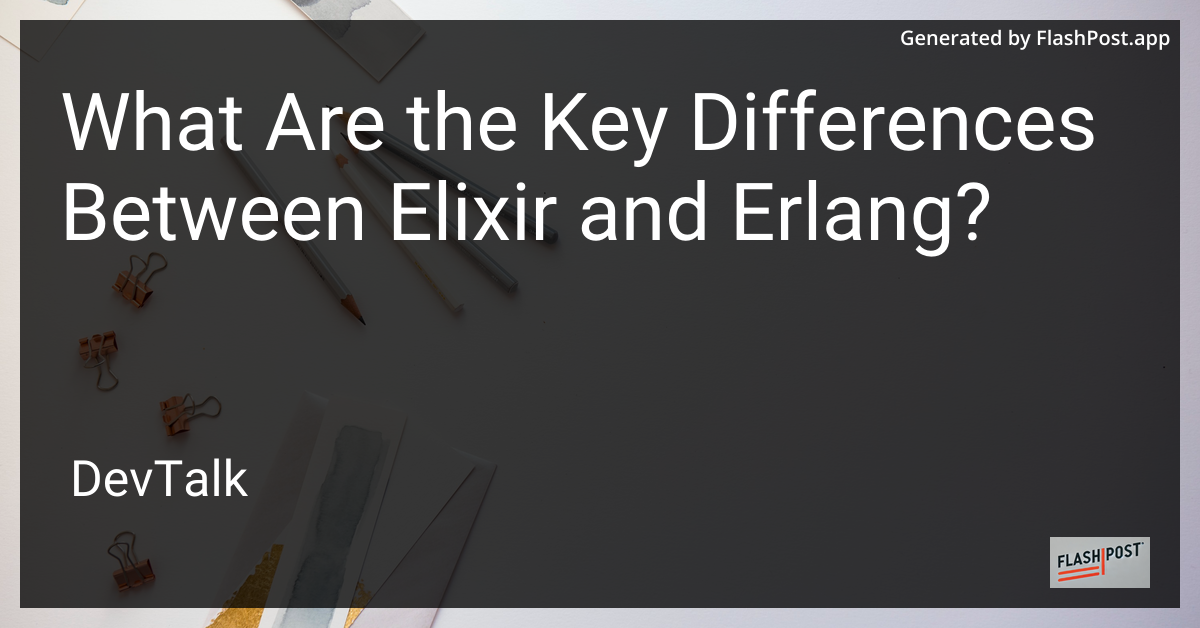What Are the Key Differences Between Elixir and Erlang?

Key Differences Between Elixir and Erlang
When diving into the world of functional programming languages, Elixir and Erlang are two names that frequently come up.
Both languages share a relationship with the Erlang Virtual Machine (BEAM), but they serve different purposes and offer unique features. Understanding the differences between Elixir and Erlang can be crucial for developers in choosing the right tool for their projects.
Origins and Background
Erlang was designed by Ericsson in the 1980s to handle telecommunication systems. Its primary attributes are concurrency, fault tolerance, and distributed computing. Elixir, on the other hand, was created by José Valim and released in 2011 to address some of the perceived limitations of Erlang. Elixir aimed to improve developer productivity and maintainability while leveraging the robust Erlang ecosystem.
Syntax and Readability
One of the stark contrasts between the two languages is their syntax. Erlang uses a syntax reminiscent of Prolog, which can be challenging for new developers to grasp. On the contrary, Elixir features a more modern and clean syntax, drawing inspiration from Ruby, making it more accessible and easier to read for humans. This has positioned Elixir as a favored language for those who prioritize readability and simplicity in code.
Tooling and Ecosystem
Elixir expands the existing Erlang ecosystem with a suite of powerful tooling options. The Elixir language includes the Mix build tool, which streamlines project management, dependency management, and also integrates testing frameworks. Additionally, the Phoenix framework in Elixir provides a robust platform for building scalable web applications, comparable to Ruby on Rails.
Erlang, while less modern in its toolset, provides excellent performance optimizations and has a proven track record in handling massive concurrent operations. Its decades of existence have resulted in a stable and optimized ecosystem for handling large-scale systems.
Concurrency Model
Both Elixir and Erlang utilize the actor model for concurrency, which runs processes independently without shared memory. This design pattern leads to systems that are more reliable and easier to scale. However, Elixir enhances the concurrency model by offering better abstractions and the introduction of tasks and agents, simplifying parallel computations. This is particularly advantageous for Elixir developers when handling concurrent operations in a more intuitive manner.
Interoperability
Elixir is built on top of Erlang, which means that it runs on the same BEAM and can seamlessly call any Erlang code. This interoperability allows developers to leverage existing Erlang libraries and tools while enjoying Elixir's syntactic and productive advantages. Such integration has greatly contributed to Elixir's growing popularity in recent years.
Community and Adoption
Erlang has a mature and stable community due to its long history, primarily involving telecommunications and high-performance systems. Elixir, while younger, has seen rapid growth and adoption across different industries, particularly for web development and concurrent applications. The vibrant and enthusiastic Elixir community continues to expand its libraries and frameworks, increasing its attractiveness to new developers.
Conclusion
Choosing between Elixir and Erlang largely depends on your project needs. If your focus is on developer productivity with modern syntax and robust web applications, Elixir could be the better fit. However, for projects where performance and stability for massive concurrent systems are paramount, Erlang remains an excellent choice.
For further insights into Elixir's capabilities, explore these resources:
Both languages offer unique strengths. Understanding these distinctions can position developers to make informed decisions, aligning technological capabilities with project requirements.
This markdown article provides an SEO-optimized overview of the differences between Elixir and Erlang, clearly detailing their features and benefits while linking to external resources on Elixir programming and development.